DOE Awards Grunder for Leadership
CEBAF welder leads diverse life
ER Director Delivers Message to CEBAF
Bright Ideas: Employee Suggestion Becomes a Reality
University Partners Across the Nation:
CEBAF Collaborations Benefit all Involved
Panic '96
CEBAF Scheduled to be Dedicated in May
CEBAF Run-A-Round on Horizon
CEBAF Celebrates African-American History Month
Teacher Conducts Research in Antartica
MIS Committee Addresses Issues and Opportunities
CIT to Market CEBAF Inventions
DOE Awards Grunder for Leadership
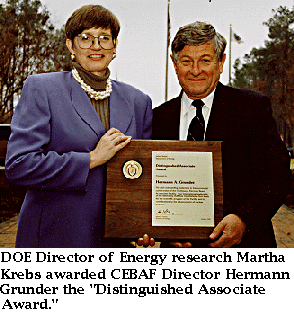
CEBAF Director Hermann Grunder was recently awarded the Department of Energy's "Distinguished Associate Award" for his outstanding leadership in the successful construction of CEBAF. During an "All Hands" staff meeting called by Director of Energy Research Martha Krebs, Grunder received a plaque signed by the Secretary of Energy Hazel O'Leary. The award to Grunder reads "Your inspirational leadership of the laboratory staff has established a firm basis for the scientific program of the facility and its contributions to the advancement of nuclear physics." After a standing ovation, Grunder told the staff that the award wouldn't have been possible without everyone's hard work and dedication.
Will CEBAF's Name Change?
Martha Krebs' recent visit to CEBAF for a DOE On-Site Review led to a series of surprise events, which may lead to a new name for the laboratory that CEBAF officials wholeheartedly agree with. During a press conference, held mainly to discuss the financial state of the Energy Research laboratories despite budget cuts, Krebs noted that people often misunderstand CEBAF's name, calling the facility "SEABASS" and other altered versions. Since then, several letters supporting the change have been offered, including one from Newport News Mayor Barry DuVal. Citing reasons for changing the name to Thomas Jefferson National Laboratory, DuVal wrote: "The proposed new name ... connects the laboratory to the patron of the founding university of the CEBAF project and SURA-the University of Virginia, and to Jefferson's reputation as one of our country's first scientists/inventors." The Mayor also highlighted the fact that Jefferson Avenue passes along the west border of the laboratory. CEBAF Director Hermann Grunder and the Associate Directors support a possible name change.
Dedicated to Quality:
CEBAF welder leads diverse life
Brian Murphy's career as a welder has led him to many places. Starting out as a welder on a production line, Murphy has since been a welding instructor at two colleges, a lead instrument welder at Fermilab, and a technical inspector for General Electric working at nuclear and fossil fuel power stations. For the past seven years, however, Murphy has worked as a senior mechanical technologist for the Accelerator Division.
Housed in building 98, a non-descript structure that looks like a large metal tool shed in front of the Counting House, Murphy works with the Cryogenics Group whose responsibilities include the assembly, testing, installation and repair of electro-magnetic and cryogenic equipment.
Murphy enjoys being involved in the construction phase of CEBAF and the relatively small size of the operation. "You work hard because of the small staff, but it is worth the effort to see the lab grow all around you. It has left me with the feeling that I have contributed to an important accomplishment," he says.
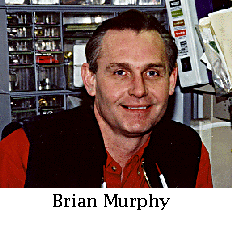 Murphy possesses several certifications and licenses including an Energy Power Research Institute certification as a mechanical inspector. He is also the safety warden for the Cryogenic Test Facility and Cryogenic Test Lab Annex. Despite all that he has accomplished, Murphy attributes his success to the people he has worked with. He also recognizes the diversity in opportunity present at CEBAF as an appealing quality. "I've worked at institutions that have had hierarchies which ran them, but CEBAF seems to utilize all of its people to develop itself," says Murphy.
Murphy possesses several certifications and licenses including an Energy Power Research Institute certification as a mechanical inspector. He is also the safety warden for the Cryogenic Test Facility and Cryogenic Test Lab Annex. Despite all that he has accomplished, Murphy attributes his success to the people he has worked with. He also recognizes the diversity in opportunity present at CEBAF as an appealing quality. "I've worked at institutions that have had hierarchies which ran them, but CEBAF seems to utilize all of its people to develop itself," says Murphy.
An example of this diversity is the fact that Murphy is the chairman of the Quality Council. The Council is a select group of representatives that were chosen from all areas and levels of the laboratory's staff in order to seek out, discuss and offer improvement solutions for quality of work issues. "It is amazing to me that someone in my position can have a place on the Quality Council and be given a chance to express my opinion on issues that affect the lab alongside scientists and administrators," he says.
In Murphy's spare time, he enjoys scuba diving, flying, and skiing. His interest in scuba diving began in the early '70's when a co-worker at Fermilab turned him on to the sport. Since then he has gone on to receive an Associate's Degree in Applied Science from the College of Oceaneering in Los Angeles, CA, for deep sea diving. Murphy has been certified by the Professional Association of Diving Instructors as an open water instructor and master scuba diver trainer. He is also a first aid instructor.
To get his adrenaline flowing, Murphy relishes overhead diving, or cave diving. "Cave diving is something out of the ordinary that not every diver is willing to try. It's very disciplined and takes a lot of planning," he says. "There's also an element of danger that gets me going. It's like a runner's high."
David Ellis, Director's Office Intern
ER Director Delivers Message to CEBAF
Martha Krebs says she wants to protect CEBAF from the frequent budget cuts that have been occurring in Washington in recent months. Her job as Director of Energy Research at the Department of Energy, is to advise the Secretary of Energy on matters of science and technology, as well as have institutional and financial responsibility for the DOE's energy research labs.
In a press conference held at CEBAF on February 22, 1996, Krebs addressed how CEBAF is affected by the recent federal budget debates in Washington. The budget cuts that the DOE has been experiencing are in applied research programs such as fusion and energy technology. These programs saw a cut of 25 percent in 1996.
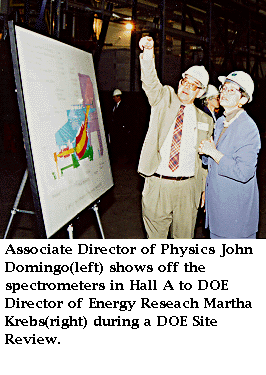 Krebs emphasized CEBAF's connections to national universities and pointed out that CEBAF has only experienced a budget cut of one to two percent in 1996. According to Krebs, "CEBAF has a leg up over other labs." CEBAF's connections to local, national, and international universities bring 1,000 users to the site. Krebs said these connections and the relationship with the community, as well as the type of research being done, are what appropriations committees in Congress look at when deciding on budget cuts. Krebs added that CEBAF's budget situation is positive because it is a "front line facility" and was "built on time and under budget."
Krebs emphasized CEBAF's connections to national universities and pointed out that CEBAF has only experienced a budget cut of one to two percent in 1996. According to Krebs, "CEBAF has a leg up over other labs." CEBAF's connections to local, national, and international universities bring 1,000 users to the site. Krebs said these connections and the relationship with the community, as well as the type of research being done, are what appropriations committees in Congress look at when deciding on budget cuts. Krebs added that CEBAF's budget situation is positive because it is a "front line facility" and was "built on time and under budget."
Krebs also stressed the importance of continuing scientific research in the next century. She says that the United States is at a disadvantage when compared to other countries because of the cuts made to the DOE. She fears that we will lose knowledge and the next generation of human resources if significant budget cuts continue to be made.
Krebs purpose for coming to CEBAF was to hold a DOE On-Site Review, on February 23, 1996. The same day she held an "all hands" meeting with staff members in the auditorium. Krebs recognized CEBAF's accomplishments, including the Hall C Christening, Dirk Walecka's 1996 Tow W. Bonner Prize in Nuclear Physics, and CEBAF's 1994 DOE M&O Contractor of the Year Award.
Krebs also stressed that CEBAF's mission centers around knowledge generation, knowledge transfer, and knowledge for public benefit. Krebs said that CEBAF needs to maintain scientific productivity, sustain research foundations, and encourage public support for science. "All reports say people love science but they don't understand what it takes to make these miracles continue to happen," said Krebs.
Rebecca James, Director's Office Intern
Bright Ideas: Employee Suggestion Becomes a Reality
Good ideas are hard to come by. When you have a great idea, it is natural to want to share it with everyone. The CEBAF Employee Suggestion Program is the perfect avenue for sharing your great ideas with the laboratory.
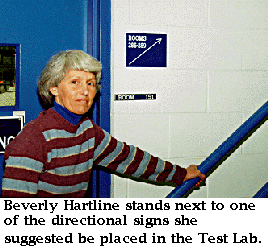 After getting lost several times on the second floor of the Test Lab, Beverly Hartline decided directional signs would be "helpful for people who don't know their way around." Joyce Miller, Cassin Riggs, Jim Takacs, Danny Machie, and Dick Brown wanted a CAD Coordinator that would service both the Accelerator and Physics Divisions. Arne Freyberger and Howard Fenker wanted an enhanced physics seminar program with a seminar held every Friday morning. These ideas were implemented this year at CEBAF through the Employee Suggestion Program.
After getting lost several times on the second floor of the Test Lab, Beverly Hartline decided directional signs would be "helpful for people who don't know their way around." Joyce Miller, Cassin Riggs, Jim Takacs, Danny Machie, and Dick Brown wanted a CAD Coordinator that would service both the Accelerator and Physics Divisions. Arne Freyberger and Howard Fenker wanted an enhanced physics seminar program with a seminar held every Friday morning. These ideas were implemented this year at CEBAF through the Employee Suggestion Program.
The program began one year ago and has had four evaluated suggestions implemented. The Suggestion Program was designed to help employees participate in improving the efficiency of CEBAF. Employee Suggestion Committee member Julie Oyer says the program "gives the employees an outlet for coming up with their own ideas to improve CEBAF." Howard Fenker appreciates the Suggestion Program as a formal mechanism for getting "the support we needed from the divisions."
If you have an idea you want to submit, yellow suggestion forms are located throughout the site and are also available on the network in the CEBAF directory under ccnt1/info/templates/msword. You can also contact a Suggestion Coordinator about attending one of your staff meetings to discuss the program.
Rebecca James,Director's Office Intern
New U.S. Citizens at CEBAF
Congratulations to staff members Kathleen Duff and Stan Majewski for recently obtaining their U.S. citizenship. Duff is a native from Guyana, South America, while Majewski is originally from Poland.
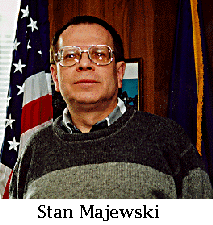 Duff, an executive secretary for the Administration Division who has lived in the U.S. since March 1988, feels privileged to become a citizen. "I made the decision that this country will be my home. Therefore, I felt that I should be in a position to participate in all the processes that help to make the United States of America the great democracy that it is," she says.
Duff, an executive secretary for the Administration Division who has lived in the U.S. since March 1988, feels privileged to become a citizen. "I made the decision that this country will be my home. Therefore, I felt that I should be in a position to participate in all the processes that help to make the United States of America the great democracy that it is," she says.
Having been in this country since April 1984, Majewski, leader of the Detector Group for the Physics Division, feels that by getting his citizenship he is merely making official that he is an American. He also shares Duff's need to participate in the democratic process. "The longer I lived in America the less European I felt. I often feel that I can appreciate more about what America is better than most of those who were born here, since I have come from a country where there is less freedom and opportunity," he says.
University Partners Across the Nation:
CEBAF Collaborations Benefit all Involved
University students and faculty members from Washington, D.C. to Washington State have helped to design and build equipment for use in all three experimental halls at CEBAF. More than 60 colleges and universities outside of the Hampton Roads area have been or are currently involved in collaborative efforts with CEBAF. The time and effort the university partners contribute to creating hardware for use at CEBAF does not go unrewarded, as they will have the opportunity to conduct experiments at CEBAF and gain experience on world class research initiatives.
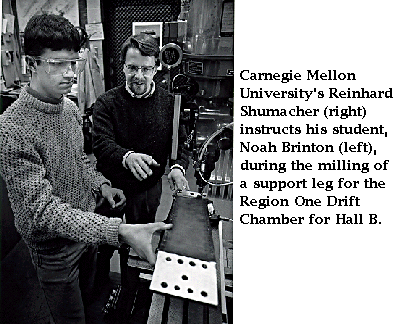 "CEBAF benefits in several ways," says Chair-Elect of the CEBAF User's Board of Directors, Betsy Beise of the University of Maryland Physics Department. Maryland's group manufactured the detector support frames for the Hall A spectrometers and copper-plated many pieces of the Hall C cryogenic target.
"CEBAF benefits in several ways," says Chair-Elect of the CEBAF User's Board of Directors, Betsy Beise of the University of Maryland Physics Department. Maryland's group manufactured the detector support frames for the Hall A spectrometers and copper-plated many pieces of the Hall C cryogenic target.
The electronic development group is working to construct summing-amplifier modules for the Hall A lead-glass shower counter. The physics group at Maryland also is constructing and testing the lead-glass shower counter for the Hall A electron spectrometer, the aerogel Cerenkov detector for the Hall C short orbit spectrometer and helping to develop the Hall C cryogenic target controls system. Hoping to use the equipment they have produced and employ what they have learned along the way, physicists at Maryland have submitted a number of proposals for experiments in Halls A and C. In addition, three Maryland students are working on Hall C experiments for their Ph.D. thesis projects.
"Universities benefit in several ways, too," says Beise. "The most important of which is that CEBAF provides resources to carry out our research and on-site physicists who have valuable expertise to help train our graduate students."
At Carnegie Mellon University in Pittsburgh, students, post-doctoral fellows and faculty members are working to construct a detector component for CEBAF's Large Acceptance Spectrometer (CLAS) in Hall B. The component, called the Region One Drift Chamber, is the innermost particle tracking detector for CLAS, which will detect charged particles coming out of the target. The device will be used by all Hall B experiments using the spectrometer. Since the project is ongoing and the spectrometer has not yet been completed, the students have developed computer programs to simulate how they expect the drift chamber to perform once it is operational. Students also have designed and constructed electronic devices to test and monitor the detector.
Reinhard Schumacher of the Carnegie Mellon Physics Department expects both the electronics work and the computer programming experience to be beneficial to his students. "What the students get out of it is valuable training," says Schumacher.
Students at the Indiana University Cyclotron Facility (IUCF) are working on experiments that will look at the inner workings of nucleons. "A small group from IUCF is involved in two experiments planned for Hall C," says Indiana University's John Cameron. In conjunction with one experiment, IUCF is constructing support stands and completing magnetic field mapping for a magnetic channel that will transport particles deflected off the target in Hall C to a polarimeter.
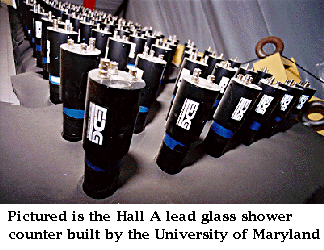
As part of another experiment, Indiana students have assisted in calibrations of the neutron polarimeter in Hall C, which is used to determine the spin of particles. According to Roger Carlini, Hall C Leader, "What's important to note is that IUCF, in conjunction with others, is working on specialized temporary spectrometers. These will utilize the flexibility of Hall C, which was designed so scientists could change its components." The equipment will be useful to those working in Hall C as a means of detecting the passage of certain charged particles.
CEBAF's university partners reach beyond Hampton Roads to encompass colleges and universities across the United States. Students at the universities benefit from the unique experimental opportunities provided at CEBAF, and CEBAF benefits from the work and hardware contributed by the universities. The relationship enhances science at CEBAF and education at the universities.
Elizabeth Sarrett, Director's Office
BRIEFLY...
PANIC '96
Along with the College of William and Mary, CEBAF will co-host the 14th Particles and Nuclei International Conference (PANIC 96) from May 22-28 in Williamsburg, Virginia. The conference, which began at CERN in 1962 and is held once every three years, addresses the subjects of particle and nuclear physics, with an emphasis on research that combines the two disciplines.
Among the events scheduled are five sessions of plenary talks, four sessions of contributed talks, poster sessions, and a tour of CEBAF. Registration is required by April 15. Registrants are encouraged to submit papers. Deadline for one-page camera-ready abstracts is March 15.
CEBAF/PANIC96
User Liaison Office
MS 12B
12000 Jefferson Avenue
Newport News, VA 23606
CEBAF Scheduled to be Dedicated in May
The same week as PANIC, CEBAF will be dedicated. Plans are underway to officially dedicate CEBAF on May 24, 1996. Hundreds of supporters, including PANIC attendees, will be invited to join the laboratory in its celebration. Special guest speakers will be invited as well. A Pig Pickin' and tours will be a major part of the celebration, so volunteers are needed. If you have any comments, suggestions or questions, please call Linda Ware at ext. 7689. To volunteer for a committee, contact Erica Murray-Hirabayashi at ext. 7883.
CEBAF Run-A-Round on Horizon
Break out those running shoes and start getting in shape, because the 11th Annual CEBAF Run-A-Round is just around the corner. The May 1st event is open to all employees, contract workers and family members age 12 and up. Awards will be made in nine categories, including the popular relay race.
Volunteers are needed to serve on the planning committee. All participants, including the volunteers, will receive a free 1996 CEBAF T-shirt. For more information or to volunteer, contact Deborah Hyman at ext. 4852 or hyman@jlab.org.
Find out more about CEBAF Recreation events on the internet at http://www.jlab.org/jag/
 Good Luck to John Alcorn who is retiring from his positon as a mechanical engineer in Hall A after 8 years of service to CEBAF. A reception was held to honor his retirement and birthday on February 29, 1996 in the SURA Residence Facility
Good Luck to John Alcorn who is retiring from his positon as a mechanical engineer in Hall A after 8 years of service to CEBAF. A reception was held to honor his retirement and birthday on February 29, 1996 in the SURA Residence Facility
CEBAF Celebrates African-American History Month
If you had a craving for JB's Bar becue or for West Indian Spiced Chicken on February 28th, the place to be was the CEBAF Center lobby. Staff participated in the International Food Festival sponsored by the CEBAF African-American History Month Planning Committee.
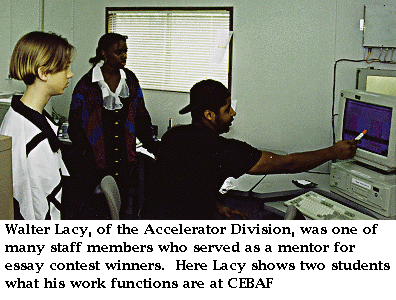 Staff and visitors were invited to bring a dish representative of their culture to the festival. Participants at the festival were treated to a variety of cultural dishes including Gloria Fleming's Puerto Rican dish Pastelon and Beverly Hartline's Austrian Apple Strudel. "My favorite was the chicken enchiladas made by Lynne Chamberlin," said Devon Massey of the Computer Center.
Staff and visitors were invited to bring a dish representative of their culture to the festival. Participants at the festival were treated to a variety of cultural dishes including Gloria Fleming's Puerto Rican dish Pastelon and Beverly Hartline's Austrian Apple Strudel. "My favorite was the chicken enchiladas made by Lynne Chamberlin," said Devon Massey of the Computer Center.
The food festival was the culminating event of African-American History Month and was attended by 23 students from Warwick High School and Crittenden Middle School. These students were honored with a day at CEBAF for winning an essay contest about an African-American who has made a significant contribution to science and/or technology.
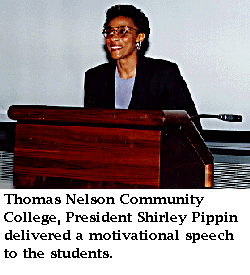 Winners spent the day at CEBAF visiting with scientists, engineers, technologists, and administrators. CEBAF's Warren Buck talked to the students about the contributions made by African American scientists and engineers, while Shirley Pippin, President of Thomas Nelson Community College, delivered a motivational speech based on her experiences while growing up. Buck and Pippin then presented each student with a certificate acknowledging their accomplishment. Lisa Surles of Science Education said, "The biggest reward was the comments from the students and their enthusiasm. They had a really good time."
Winners spent the day at CEBAF visiting with scientists, engineers, technologists, and administrators. CEBAF's Warren Buck talked to the students about the contributions made by African American scientists and engineers, while Shirley Pippin, President of Thomas Nelson Community College, delivered a motivational speech based on her experiences while growing up. Buck and Pippin then presented each student with a certificate acknowledging their accomplishment. Lisa Surles of Science Education said, "The biggest reward was the comments from the students and their enthusiasm. They had a really good time."
Other February activities included a play featuring several literary greats called "Tireless Spirits-A Salute to the Literary Geniuses of the Harlem Renaissance," put on by the Hampton Players and Company of Hampton University on February 15th. And a presentation at the CEBAF Science Series featured Anthony Johnson, Physics Department Chair for the New Jersey Institute of Technology, who spoke on "Lasers and Ultrafast Optical Phenomena" on February 27th.
Planning has already begun for next year's celebration. To join the planning committee or to make suggestions, please contact Deborah Hyman at ext. 4852 or at hyman@jlab.org.
Rebecca James, Director's Office Intern
Teacher Conducts Research in Antarctica
During the cold winter months, thoughts turn to lazy vacations in steamy tropical locales. Tom Spencer is not your average vacationer. The former CEBAF SITE and TRAC participant went on a working vacation in the sub-zero temperatures of Antarctica.
From January 3 to February 5, Spencer worked at the South Pole as a participant in the Antarctic Research Experience (ARE). "The ARE program is run much like CEBAF's Teacher Research Association (TRAC) program. Teachers are assigned to mentors based on their abilities and interests," he says.
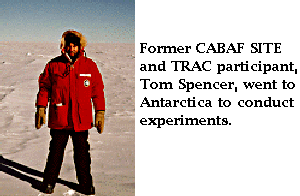 Spencer, the engineering program instructor for the Chesapeake Center for Science and Technology, was nominated by Bill Williams, CEBAF's former BEAMS Program Manager and now the laboratory training manager, for one of four positions available nationwide in the ARE program. "I nominated Tom because of the enthusiasm and energy he displayed when he participated in our SITE and TRAC programs," says Williams. "I also knew that Tom would share his experiences and knowledge with other teachers and students."
Spencer, the engineering program instructor for the Chesapeake Center for Science and Technology, was nominated by Bill Williams, CEBAF's former BEAMS Program Manager and now the laboratory training manager, for one of four positions available nationwide in the ARE program. "I nominated Tom because of the enthusiasm and energy he displayed when he participated in our SITE and TRAC programs," says Williams. "I also knew that Tom would share his experiences and knowledge with other teachers and students."
While in Antarctica, Spencer was assigned to work on the Antarctic Muon And Neutrino Detector Array (AMANDA). Consisting primarily of photomultiplier tubes (PMT's), AMANDA is a special telescope which detects high energy particles (neutrinos) that travel from the North Pole, through the earth and exit through the ice at the South Pole.
He worked on many aspects of the project from the electronics to a video camera that would be lowered 2 kilometers into the ice in order to study ice properties. Spencer was allowed to operate the drill that created a 2033.4 meter hole [a record depth for hot water drilling] needed for AMANDA's deployment.
In addition to his work with AMANDA, Spencer made himself available to teachers and students who had an interest in science and technology-related topics via e-mail and the Internet. Spencer conducted experiments for teachers and their classes, answered questions about the environment of the South Pole, and developed lesson plans for use by the program participants.
To prepare for his trip to Antarctica, Spencer went to the University of Wisconsin over the summer to work on AMANDA's previous year's drilling data, and to learn how to operate the computer controls for the drill. "I also had to quit drinking coffee and alcoholic drinks which is recommended, because at 9300-feet above sea-level those things increase your chances of getting altitude sickness or suffering from dehydration," says Spencer.
The first leg of his trip began in Christchurch, New Zealand where he was outfitted with extreme cold weather gear as he waited for good weather in order to fly into Antarctica. At the pole, Spencer found the accommodations to be quite pleasing. "The cold weather gear was very good at keeping out the cold, which was around negative 27 degrees below zero. The food was great and I was able to take a two minute shower every three days," he says.
Spencer hopes that his Antarctic and CEBAF experiences will help him to become a better teacher. "A German scientist I was with in Antarctica said that he believed students could tell which teachers have experience in the subjects they teach, and that the students will develop respect [for the teacher] accordingly," he says. "Students can tell if you are explaining something that you have never tried before."
David Ellis, Director's Office Intern
MIS Committee Addresses Issues and Opportunities
As CEBAF moves into the operational phase, new issues and opportunities arise relative to the laboratory's information systems. Modern technology allows us to electronically submit stock reports, track training and time sheets, and follow funding. Examples of these systems at CEBAF include CIS (CEBAF Information System), the requisition system, the stock system, and Finance's Deltek system. The goal for these systems is to enhance productivity. The issues involve making the trade-offs on the level of resources to apply to the spectrum of available options while keeping the Laboratory's mission in the forefront.
To address this and other information issues, the Management Information System (MIS) Advisory Committee was created and tasked to:
Make recommendations on site-wide strategies and priorities in MIS development.
Evaluate and prioritize new MIS applications and major modifications.
Provide the MIS coordination function between Administration Division departments, administrative functions in other divisions, Computer Center, and committees and task forces which come up with MIS-related requirements.
Since it's inception in August of 1995, the MIS Committee has surveyed MIS requirements and organized them into a prioritized list according to the value the request would add to the laboratory. Priority was based on the number of people impacted, improved productivity of staff, improved quality of product, performance measures requirements, and how quickly/easily the request can be instituted. The fifth priority was added to ensure that useful requests that could be quickly and easily instituted would not have to wait in line behind something that might add more value to the laboratory in general but take months to implement.
Top priority items on the MIS Committee's major applications list includes providing improved financial reports to cost account managers, instituting a site-wide electronic time sheet application, and development of a site-wide training database. The MIS Committee has helped facilitate several smaller projects including SWIS (Site-Wide Information System), the development of Accelerator Division's Five Star Training Database, a database to more accurately track available space across the site, restructuring of the supervisory chain in CIS, and correcting interface problems between the requisition system and Deltek. All of these make up only part of the initial application requests list!
If you have any MIS questions or concerns, contact the MIS Committee representative for your division.
|
MIS Committee Division representatives |
Milissa Klienfelder, User Liaison Office Staff Assistant
CIT to Market CEBAF Inventions
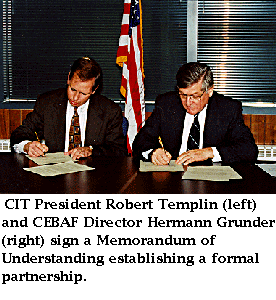 CEBAF and the Center for Innovative Technology (CIT) signed a Memorandum of Understanding on January 17th that will allow the organization to market CEBAF inventions to industry. The partnership will include establishing specific working relationships and programs between CEBAF, industry and CIT to best achieve technology transfer.
CEBAF and the Center for Innovative Technology (CIT) signed a Memorandum of Understanding on January 17th that will allow the organization to market CEBAF inventions to industry. The partnership will include establishing specific working relationships and programs between CEBAF, industry and CIT to best achieve technology transfer.
CIT was created by the Virginia General Assembly in 1984 as a non-profit organization designed to enhance the Commonwealth's competitiveness by providing businesses with access to the state's resources and assist in the creation and retention of high technology jobs and businesses.
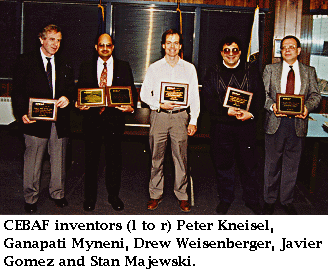 Five scientists were awarded at the ceremony for inventions they created while pursuing CEBAF's fundamental research mission. SURA recently received three patents for these inventions and will share future royalties with the inventors. CEBAF rewards the scientists $500 for each spin-off technology.
Five scientists were awarded at the ceremony for inventions they created while pursuing CEBAF's fundamental research mission. SURA recently received three patents for these inventions and will share future royalties with the inventors. CEBAF rewards the scientists $500 for each spin-off technology.
The CEBAF scientists and inventions are: Javier Gomez, Stan Majewski and Andrew Weisenberger for the invention of a Non Cross Talk Multi-Channel Photomultiplier Using Guided Electron Multipliers; Ganapati Myneni for a High Sensitivity Leak Detection Method and Apparatus; and Ganapati Myneni and Peter Kneisel for the invention of a Metal Sponge for Cryosorption Pumping Applications.

